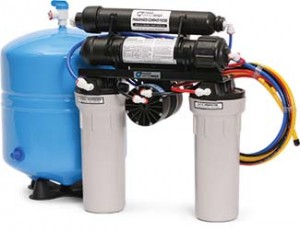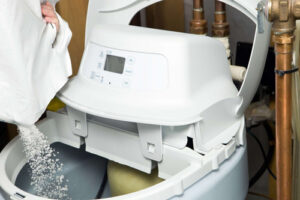
Understanding Reverse Osmosis
Reverse Osmosis Systems use a process that reverses the flow of water in a natural process of osmosis so that water passes from a more concentrated solution to a more dilute solution through a semi-permeable membrane. Pre- and post-filters are often incorporated along with the reverse osmosis membrane itself. The filter typically has a pore size of approximately 0.0001 micron.*
Reverse osmosis is a water filtration system used around the world to help improve water for drinking, cooking and other important uses. Yet, there is some debate over the health benefits of reverse osmosis water. We’ll dissect the information understand the health benefits and risks.
Lead Removal:
According to the Centers for Disease Control and Prevention (CDC), a reverse osmosis filtering system can effectively remove lead, thus making healthy water that is safe for consumption. Excess levels of lead in the body can result in increased blood pressure, problems with fertility and development of nerve and muscle damage. Lead may even lead to brain damage and cause severe anemia in children.
Reverse osmosis systems are also effective at removing other common chemicals, including chloride, copper, and chromium.
Filters Protozoa:
According to the CDC, reverse osmosis is highly effective in removing protozoa, such as cryptosporidium, a parasite found in contaminated water. Once ingested, this parasite affects the small intestines, causing stomach cramps, fever and diarrhea. Children who ingest this parasite can experience dehydration and malnutrition.
Safe Water Cancer Patients:
Cancer patients can consume reverse osmosis water during and after cancer treatment, reports Medline Plus, due to its high level of filtration. Reverse osmosis systems have a very high effectiveness in removing viruses and bacteria. Cancer patients, especially during radiation or chemotherapy, have weakened immune systems. Using untreated water for cooking and drinking that contains harmful micro-organisms and tiny germs can cause infection.
Removes Sodium:
The process of reverse osmosis removes sodium molecules from water, reports the CDC. Large sodium molecules cannot pass through the membranes of the reverse osmosis filtering system. Drinking reverse osmosis water therefore provides benefits to people with high blood pressure, kidney or liver disease or any sodium restrictions.
Mineral Replacement:
The downside of reverse osmosis water is a lack of minerals, but ingesting mineral-free purified water is not harmful to your body. To replace the minerals in your drinking water eat plenty of vegetables, fruits, nuts, and seeds, and you will be optimally mineralized and alkalized.
The H6500 Reverse Osmosis drinking water system is a highly efficient reverse osmosis unit that typically removes 97-98% of dissolved solids from your water. In fact, the H6500 reduces contaminants found in a household’s water supply such as Arsenic (Pentavalent) <=50 ppb, Barium, Cadmium, Cyst, Fluoride, Chromium (Hexavalent), Lead, TDS, Chromium (Trivalent), Nitrate/Nitrite, Radium 226/228 and Selenium. Combined with a whole house filtration system, your entire house will reap the benefits of clean, healthy water.
Read more about Reverse Osmosis here.
*https://www.cdc.gov/healthywater/drinking/home-water-treatment/household_water_treatment.html





